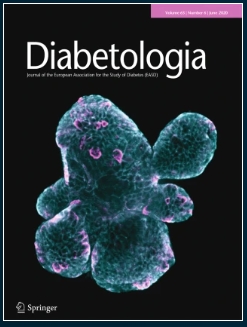三维电子显微镜显示糖尿病视网膜神经血管单位的新超微结构变化。
IF 10.2
1区 医学
Q1 ENDOCRINOLOGY & METABOLISM
引用次数: 0
摘要
目的/假设:本研究使用x-y-z平面的纳米级成像技术——连续块面扫描电镜(SBF-SEM)来研究糖尿病相关视网膜神经血管单元(NVU)的三维超微结构变化。我们假设这种方法将揭示以前未表征的病理改变,这些病理改变有助于糖尿病视网膜疾病(DRD)的发展。方法制备雄性糖尿病小鼠和非糖尿病小鼠的视网膜,以及患有和不患有糖尿病的男性供体的视网膜进行SBF-SEM成像。显微解剖视网膜组织,固定并嵌入连续切片和三维重建。在小鼠和人视网膜浅表血管丛毛细血管区进行了NVU的超微结构分析。使用显微图像浏览器处理图像堆栈,进行对比度归一化和分割,并在Amira软件中进行3D可视化。定量分析周细胞-内皮细胞钉窝形成、细胞-基底膜(BM)相互作用、内皮小管形成和血管基底膜厚度。结果ssbf - sem显示糖尿病小鼠和人视网膜NVU出现新的三维超微结构变化,包括:(1)部分脱离,周细胞-内皮栓孔形成频率降低(p<0.05 ~ 0.001);(2)内皮细胞和周细胞局部脱离血管基底(p<0.05-0.01),同时大胶质细胞从外血管基底退缩;(3)内皮小管形成增加(p<0.01-0.001)。这些变化是在没有任何明显的血管基底膜增厚的情况下观察到的,因为在本研究中,糖尿病患者和非糖尿病患者的视网膜毛细血管在平均或最大基底膜厚度上没有发现显著差异。结论/解释本研究为DRD视网膜NVU的早期超微结构变化提供了新的见解,为更好地理解导致该疾病发展的病理过程提供了基础。数据可用性本文分析的所有原始图像堆栈的链接可在https://doi.org/10.5281/zenodo.15210333上获得。MATLAB血管BM厚度测量脚本可在GitHub链接https://github.com/Curtis-WWIEM/BM_thickness。本文章由计算机程序翻译,如有差异,请以英文原文为准。
3D electron microscopy reveals novel ultrastructural changes in the diabetic retinal neurovascular unit.
AIMS/HYPOTHESIS
This study used serial block-face scanning electron microscopy (SBF-SEM), a nanoscale imaging technique in x-y-z planes, to investigate 3D ultrastructural changes in the retinal neurovascular unit (NVU) associated with diabetes. We hypothesised that this approach would reveal previously uncharacterised pathological alterations that contribute to the development of diabetic retinal disease (DRD).
METHODS
Retinas from male diabetic and non-diabetic mice, as well as from human male donors with and without diabetes, were prepared for SBF-SEM imaging. Retinal tissue was microdissected, fixed and embedded for serial sectioning and 3D reconstruction. Ultrastructural analysis of the NVU was performed in capillary regions exclusively within the superficial vascular plexus of both mouse and human retinas. Image stacks were processed using Microscopy Image Browser for contrast normalisation and segmentation, with 3D visualisation performed in Amira software. Quantitative analyses were conducted on pericyte-endothelial cell peg-and-socket formations, cell-basement membrane (BM) interactions, endothelial tubule formation and vascular BM thickness.
RESULTS
SBF-SEM revealed novel 3D ultrastructural changes in the retinal NVU of diabetic mice and humans, including: (1) partial detachment and reduced frequency of pericyte-endothelium peg-and-socket formations (p<0.05-0.001); (2) localised detachment of endothelial cells and pericytes from the vascular BM (p<0.05-0.01), along with macroglial cell retraction from the outer vascular BM; and (3) increased formation of endothelial tubules (p<0.01-0.001). These changes were observed in the absence of any obvious vascular BM thickening, as no significant differences in mean or maximum BM thickness were found between diabetic and non-diabetic retinal capillaries analysed in this study.
CONCLUSIONS/INTERPRETATION
This study provides new insights into the early ultrastructural changes in the retinal NVU in DRD, offering a basis for a better understanding of the pathological processes that contribute to the development of this disease.
DATA AVAILABILITY
Links to all raw image stacks analysed in this article are available at https://doi.org/10.5281/zenodo.15210333 . The MATLAB vascular BM thickness measurement script is available at the GitHub link https://github.com/Curtis-WWIEM/BM_thickness .
求助全文
通过发布文献求助,成功后即可免费获取论文全文。
去求助
来源期刊

Diabetologia
医学-内分泌学与代谢
CiteScore
18.10
自引率
2.40%
发文量
193
审稿时长
1 months
期刊介绍:
Diabetologia, the authoritative journal dedicated to diabetes research, holds high visibility through society membership, libraries, and social media. As the official journal of the European Association for the Study of Diabetes, it is ranked in the top quartile of the 2019 JCR Impact Factors in the Endocrinology & Metabolism category. The journal boasts dedicated and expert editorial teams committed to supporting authors throughout the peer review process.
 求助内容:
求助内容: 应助结果提醒方式:
应助结果提醒方式:


